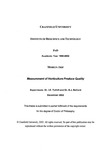JavaScript is disabled for your browser. Some features of this site may not work without it.
| dc.contributor.advisor | Tothill, Ibtisam E. | |
| dc.contributor.advisor | Setford, S. J. | |
| dc.contributor.author | Arif, Mobeen | |
| dc.date.accessioned | 2020-04-06T11:40:42Z | |
| dc.date.available | 2020-04-06T11:40:42Z | |
| dc.date.issued | 2002-12 | |
| dc.identifier.uri | http://dspace.lib.cranfield.ac.uk/handle/1826/15370 | |
| dc.description.abstract | The aim of this work was to develop amperometric biosensors, for the detection of key analytes that affect horticulture produce quality. Information was gathered relating to the interaction between key analytes, such as amino acids, organic acids and sugars and their effect on produce quality. Trends of these key analytes changed in the produce over time, thus their measurement can indicate ripeness. A taste panel analysis on six varieties of tomatoes was therefore carried out. The key analytes were then measured by conventional means and the data was subjected to Principal Component Analysis (PCA). The results indicate that total organic acids correlate well with perceived sweetness of tomatoes. Individual amperometric biosensors for the measurement of L-malic acid, D- glucose, L-ascorbic acid, L-amino acids, and L-glutamic acid were developed during the course of this study. These individual biosensors were tested with real samples and the results were compared with standard photometric tests. The biosensors generally gave high precision values. The L-malic acid biosensor showed a high correlation against the standard method (accuracy = > 87.3 % when testing real samples). One of the problems encountered when testing real samples was the effect of interferent species. Therefore, quantification of the interferent effect was achieved by testing the sample with and without enzyme immobilised onto the working electrode. By calculating the difference in current, an accurate concentration of the target analyte could be measured. Finally, it was understood through the course of this work that measurement of only single analytes is insufficient in determining the quality of horticulture produce. Therefore a multianalyte biosensor was constructed. D-glucose, L-malic acid, and L- ascorbic acid, were tested simultaneously using this biosensor array. The average accuracy of this method, as compared to detection of single analytes was 90 %. | en_UK |
| dc.language.iso | en | en_UK |
| dc.rights | © Cranfield University, 2015. All rights reserved. No part of this publication may be reproduced without the written permission of the copyright holder. | |
| dc.title | Measurement of horticulture produce quality. | en_UK |
| dc.type | Thesis | en_UK |
